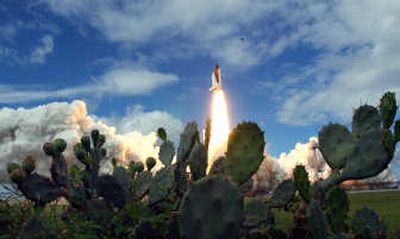Challenging mission awaits shuttle crew

CAPE CANAVERAL, Fla. – With one perilous challenge overcome, the space agency and the crew of shuttle Discovery now confront two other major tests: an extremely demanding mission and a more-worrisome-than-usual return to Earth.
“Just a tremendous series of challenges in front of us,” said Bill Gerstenmaier, an associate administrator for NASA. “I can’t think of a better start to this mission than what we got today.”
The seven astronauts embarked Tuesday on a 14-day mission to the International Space Station, blasting off from the Kennedy Space Center right on schedule and safely reaching orbit 8 1/2 minutes later.
Discovery’s crew is assigned to deliver and install a new 31,500-pound module called Harmony, the first expansion of the orbiting laboratory’s living and working space since 2001.
“We’re ready to take Harmony to her new home,” shuttle commander Pamela Melroy, only the second woman to lead a shuttle mission, said just before launch.
The crew also must move a 35,000-pound solar array and truss from one part of the station to another.
Those tasks and others will require five arduous spacewalks, the delicate manipulation of robotic arms attached to the shuttle and the station, and the assistance of the station’s three crew members.
“By any measure, this is one of the most challenging and audacious missions in the shuttle-ISS era,” said crew member Scott Parazynski, who should know. He is a veteran of four previous shuttle flights.
In addition, the crew will engage in an especially important in-flight inspection of Discovery, devoting particular attention to the integrity of its wings.
The protective coating along the wings’ leading edges – a crucial shield that protects craft and crew from the 3,000-degree heat generated by re-entry through the atmosphere – has shown unusual signs of decay.
In February 2003, a hole punched by launch debris in the leading edge of one of Columbia’s wings triggered the cascade of events that destroyed that shuttle and killed its seven crew members.
With that in mind, a safety committee recommended postponing Discovery’s mission until three of the 44 “reinforced carbon-carbon” panels could be replaced, but NASA decided to proceed.
Managers said the decay remained stable through several previous flights and they believe the defects do not pose an unacceptable hazard.